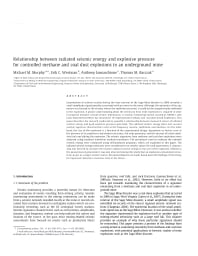Mining Publication: Relationship Between Radiated Seismic Energy and Explosive Pressure for Controlled Methane and Coal Dust Explosions in an Underground Mine
Original creation date: March 2012
Authors: MM Murphy, EC Westman, AT Iannacchione, TM Barczak
NIOSHTIC2 Number: 20040510
Tunn Undergr Space Technol 2012 Mar; 28:278-286
Examination of seismic records during the time interval of the Sago Mine disaster in 2006 revealed a small amplitude signal possibly associated with an event in the mine. Although the epicenter of the signature was located in the vicinity where the explosion occurred, it could not be unequivocally attributed to the explosion. A greater understanding about the seismicity from mine explosions is required in order to properly interpret critical seismic information. A seismic monitoring system located at NIOSH’s Lake Lynn Experimental Mine has monitored 16 experimental methane and coal dust-based explosions. This paper describes the research conducted to quantify a relationship between measured values of radiated seismic energy and peak explosive pressure generated. The radiated seismic energy takes into account seismic signature characteristics such as the frequency content, amplitude, and duration. On the other hand, the size of the explosion is a function of the experimental design, dependent on factors such as the presence of an explosion-containment structure, the mine geometry, and the amount of initial explosive fuel used during the explosion. The seismic signatures from methane and coal dust explosions were analyzed using standard waveform analysis procedures. The procedures used to estimate the radiated seismic energy were conducted using self-produced programs, which are explained in this paper. The radiated seismic energy estimates were considered to be relative values for each experiment. A relationship was derived to correlate the relative radiated seismic energy to the size of the explosion, defined as the peak pressure generated. It was also observed during this study that an explosion-containment structure can act as a major seismic source. Recommendations are made, based upon the findings of this study, for improved collection of seismic data in the future.

NIOSHTIC2 Number: 20040510
Tunn Undergr Space Technol 2012 Mar; 28:278-286
- Analysis of Seismic Signatures from Gas and Dust Based Explosions at the Lake Lynn Experimental Mine
- Detonation Wave Propagation in Underground Mine Entries
- Explosion Pressure Design Criteria for New Seals in U.S. Coal Mines
- Historical Development of Technologies for Controlling Methane in Underground Coal Mines
- Initial Study of Buried Communication Cable for Underground Mines
- Progress Toward Improved Engineering of Seals and Sealed Areas of Coal Mines
- Rock Damage Characterisation from Microseismic Monitoring
- Rock Dusting Considerations in Underground Coal Mines
- Technology News 490 - An Inexpensive Device for Monitoring Explosions in Sealed Areas of Underground Mines
- Technology News 535 - NIOSH Releases New Educational Video: Escape from Farmington No. 9: An Oral History